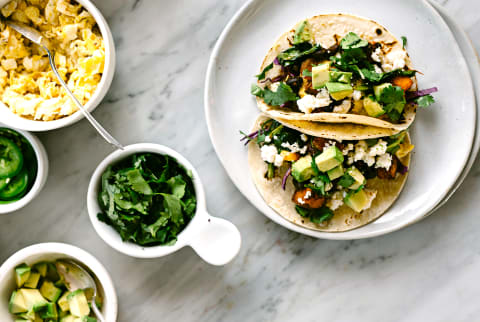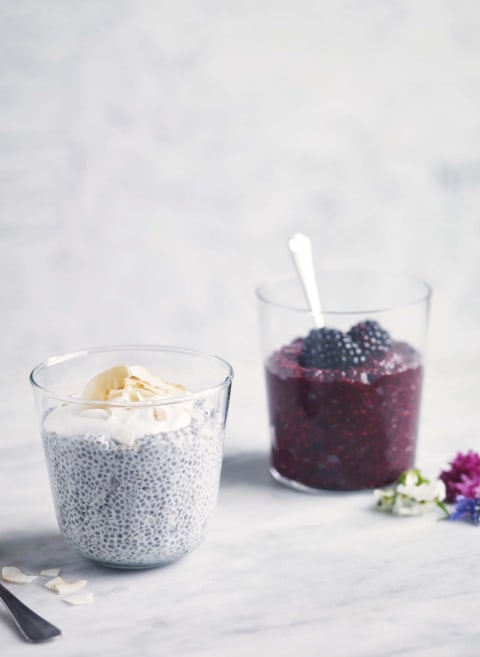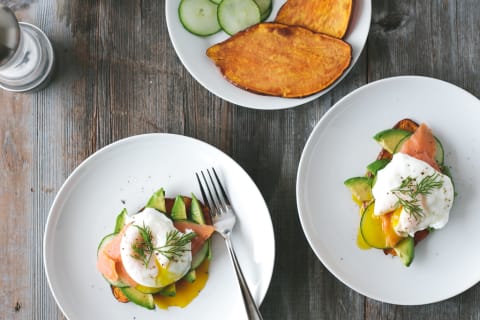
mbg Sustainability + Health Director
mbg Sustainability + Health Director
Emma Loewe is the Senior Sustainability Editor at mindbodygreen and the author of “Return to Nature: The New Science of How Natural Landscapes Restore Us.”

Expert review by
Registered Dietitian
Lauren Torrisi-Gorra, MS, RD is a registered dietitian, chef, and writer with a love of science and passion for helping people create life-long healthy habits. She has a bachelor’s degree in Communication and Media Studies from Fordham University, a Grand Diplôme in Culinary Arts from the French Culinary Institute, and master’s degree in Clinical Nutrition and Dietetics from New York University.

Image by Cameron Whitman / Stocksy
January 30, 2024
Most Americans don’t eat enough fiber, which makes sense when you consider our popular breakfast staples: bacon and eggs have zero grams of fiber, while pancakes might deliver a measly 1-2 grams.
Fiber is a complex carb that’s essential for gut health, digestive regularity, blood sugar balance, and satiety—so it’s worth getting more of with your morning meal. Here are the benefits of a high-fiber breakfast, how much fiber to aim for, plus quick recipes and easy tips to help set you up for a smoother day (in every sense of the word).
The need-to-knows:
- Most Americans don’t get enough fiber: Up to 95% of us don’t reach the recommended amount of fiber: 25 to 28 grams a day for women and 38 grams a day for men. Getting fiber at breakfast (at least 6 grams, roughly) can help you close the fiber gap.
- High-fiber breakfasts aren’t just good for your poop schedule: Beyond promoting regular digestion, eating plenty of fiber can improve gut health, support healthy blood sugar, and increase immunity.
- Start low and go slow: Upping your fiber intake too quickly may lead to bloating, gas, diarrhea, and/or constipation, which is something to be mindful of if you’re currently eating breakfasts that are lower in fiber.
High-fiber breakfast benefits
Here are a few reasons to pack your breakfast with fiber:
1.
Most people don’t get enough fiber
According to recommendations from The National Academies1, women under 50 need at least 25 to 28 grams of fiber per day, while men under 50 need at least 38 grams daily.
Starting to consume fiber with your first meal is a smart way to close this “fiber gap” early in the day. “When it comes to fiber, it’s really important to get it throughout the day. But taking it in at breakfast is a great way to start your day with fiber,” Maggie Moon, R.D., a brain health nutrition expert and author of The MIND Diet, tells mindbodygreen.
2.
High-fiber breakfasts are filling and energizing
In the process, fiber also helps stabilize energy levels. “[Eating a high-fiber breakfast is] a way to moderate how energy is going to be utilized throughout the mornings and keep you fuller longer,” says Moon.
3.
Fiber is great for gut health
Fiber isn’t fuel just for us—it’s nourishment for the trillions of microbiota living in our guts.
“The bacteria can feed on the complex carbohydrates in fiber, then produce postbiotics like short-chain fatty acids, aka SCFAs (which also contribute to gut health),” research scientist Michael Lelah, Ph.D., previously told mindbodygreen.
These fatty acids also support gut barrier integrity, making fiber an important nutrient for fortifying the gut lining10, says celebrity dietitian and nutrition therapist Kim Shapira, M.S., R.D. This can have a positive ripple effect on immunity too since approximately 70% to 80%11 of immune cells reside in the GI tract.
4.
High-fiber breakfasts can help make you more regular
The two types of fiber—soluble and insoluble—work in tandem to promote healthy and regular bowel movements. Insoluble fiber helps bulk up the stool and speed up elimination, while soluble fiber forms a gel that makes stool easier to pass. If you don’t get enough of both types of fiber, chances are your bathroom visits aren’t as regular or comfortable as they could be.
“If you have 12 grams of fiber on Monday and 13 grams on Tuesday, you are not pooping until Wednesday,” says Shapira.
High-fiber breakfast staples
When it comes to fiber, variety is key. Switching up your fiber sources can help ensure you get a mix of soluble and insoluble fibers, plus plenty of different gut-fueling polyphenols. Here are a few high-fiber foods to have in your breakfast rotation:

Breakfast foods with little or no fiber:
- Eggs
- Bacon and other breakfast meats
- Yogurt
- Milk
- Cream cheese
Recipes
These breakfast recipes all pack at least 6 grams of fiber—plus plenty of healthy fats and protein. There’s an option on the list for every breakfast mood—whether you’re craving something sweet or savory, super simple or a little fancy. If you don’t currently get much fiber in your diet, start with recipes that contain lower amounts before gradually working your way up.
1.
Keto-Inspired Omelet

Image by Ksenia Avdulova / Contributor
Approximate fiber per serving: 6 grams
This recipe calls for avocado, arugula, and sauerkraut, but you can add any vegetables you happen to have in your fridge. Don’t be afraid to mix things up! “If you’re mostly getting your fibers from grains, beans, lentils, and legumes, you’re missing out on other nutrients from fruits and vegetables. Mixing up your fibers is very important,” says Shapira.
2.
Lemony Lentil Bowl
Approximate fiber per serving: 6-7 grams
Any food can be a breakfast food if you want it to be—including fiber-packed lentils. Make a full batch of this veggie- and legume-stuffed salad for a savory breakfast that will last you all week. Top it with an egg and enjoy.
3.
Yogurt Bowl With Berries & Seeds
Approximate fiber per serving: 13 grams
Yogurt is fiber-free, so this recipe combines it with a fiber supplement and frozen berries. You can boost the fiber count and gut health benefits even more by topping your yogurt with the seed of your choice.
“I pretty much recommend that every single person that I come in contact with adds flax, chia, or hemp seeds to their breakfast,” Shapira jokes, adding that they’re also full of brain-healthy omega-3s.
4.
Chocolate Buckwheat Pancakes
Approximate fiber per serving: 8 grams
This delicious short stack mimics the chocolate chip pancakes you know from growing up—without the ensuing blood sugar crash. They call on nutty buckwheat flour, which packs a whopping 12 grams of fiber per cup, and antioxidant-rich cacao for an elevated version of the childhood classic.
5.
Hummucado Toast
Approximate fiber per serving: 8 grams
Boost the fiber content of your avocado toast by spreading hummus or another bean dip on top of your mashed avo. From there, you can add the toppings of your choice; Moon likes to brighten the flavors up with radishes and a squeeze of lemon juice.
6.
An Apple & a Handful of Walnuts
Approximate fiber per serving: 6 grams
When Moon wants to get her morning off to a nutritious start but doesn’t have time for a sit-down breakfast, she’ll nosh on an apple (4 grams of fiber) and a handful of walnuts (2 grams of fiber). This makes for a great combo because “I’m getting fiber, I’m getting fluids, I’m getting healthy omega-3 fatty acids from the walnuts—and I’m getting the vitamins and minerals that go along with those packages,” she says.
7.
Berry Chia Pudding

Image by Nassima Rothacker / Contributor
Approximate fiber per serving: 13 grams
Chia pudding is an easy make-ahead breakfast that can pack a significant amount of fiber depending on what you add to it. This version combines blueberries, cardamom, and maple syrup for a cozy, slightly sweet treat.
8.
Cacao-Nut Oatmeal
Approximate fiber per serving: 8-9 grams
Oatmeal is a decent source of fiber and serves as a blank canvas for all sorts of other plant toppings. This energizing recipe calls on pepitas, almonds, honey, banana, and cacao—but you can also go the savory route with additions like miso or mushrooms!
9.
Sweet Potato Breakfast Patties
Approximate fiber per serving: 8 grams
These Mediterranean-inspired patties are far from your typical breakfast. They combine sweet potato, lentils, and blueberries for a sweet-savory fritter that pairs perfectly with yogurt.
10.
Blueberry oat smoothie
Approximate fiber per serving: 10-11 grams
Smoothies are a perfect vehicle for fiber-rich ingredients like berries, oats, and bananas. This recipe uses plant-based milk and supplemental guar bean fiber to boost the count even further.
11.
Sweet Potato “Toast” With Lox

Photo by Lisa Bryan / Contributor
Approximate fiber per serving: 10-11 grams
Sweet potatoes take the place of bread in this gluten-free twist on avocado toast. They take a trip to the oven until lightly charred and then get topped with avocado, cucumber, smoked salmon, and dill for a delightfully flavorful and filling breakfast.
11.
Raspberry Chia Jam Sandwich
Approximate fiber per serving: 23 grams
For a portable breakfast that elevates the humble PB&J, try this spin that’s packed with fiber and protein. Opt for a high-fiber multigrain bread if you can.
How much fiber do you need at breakfast?
As long as you’re getting the recommended 25+ grams of fiber a day, it doesn’t necessarily matter how you break it up.
However, Moon notes that spreading out your fiber intake across every meal and snack will likely be more comfortable than getting most of it in one sitting. Plus, distributing it this way will promote sustained energy and blood sugar balance throughout the day. There’s also research to show that including at least 6 grams of fiber in every meal can benefit heart health, decreasing triglyceride and LDL (“bad”) cholesterol levels while increasing HDL (“good”) cholesterol21.
By this logic, getting 6-8 grams of fiber from breakfast is a solid goal. Here are a few quick ways to up your fiber intake and reach 6-8 grams without much effort (or macro counting):
- See how many colorful fruits and vegetables you can pack into your breakfast
- Top your breakfast with chia or hemp seeds
- Opt for high-fiber cereals or English muffins
- Keep the skins on your fruits and vegetables
- Experiment with savory breakfasts that contain fiber-rich ingredients like lentils
Other perspectives on high-fiber breakfasts
Given fiber’s many benefits, you may be tempted to pack a ton of it in your breakfast. But beware that going from 0 to 100 with fiber may lead to some uncomfortable side effects like constipation, diarrhea, gas, and bloating.
“Since fiber binds with water, eating a lot of it will tract a lot of water into the gut. And that might, in a counterintuitive way, make you more constipated,” explains Moon.
This reaction can cause some people to think that high-fiber breakfasts just aren’t for them—but that’s not necessarily true.
To keep fiber from overwhelming your system, aim to add it to your diet more gradually. If you currently eat 5 grams a day, for example, Shapira recommends adding 5 additional grams a day until you reach 25 grams. Even then, you may notice that it takes another week or so before you notice any positive changes in your digestion. “Most people would want to quit—don’t! Stick with it. Slow and steady,” she recommends.
If you’re new to high-fiber breakfasts, you’ll also want to start with sources of fiber that are less concentrated and have a high water content. (Say, oranges and apples over black beans and lentils.) This can help your body adjust to the new carb sources.
Summary
You may experience bloating, gas, diarrhea, and/or constipation when you start to increase your fiber intake. If you do, aim to eat less concentrated sources of fiber and give your body a few days to get used to them.
The mindbodygreen POV
Breakfast really is the most important meal of the day. Our first meal can help stabilize blood sugar, increase energy, boost cognitive performance, and more. A healthy breakfast should contain a mix of high-quality protein (for muscle and metabolic benefits), healthy fats (for vitamin absorption), and fiber (for gut and digestive health).
Aiming to pack at least 6-8 grams of fiber into your breakfast can help give you a head start on your daily fiber needs (25+ grams). This fiber can come from an array of fruits, vegetables, legumes, and other plant sources. There are benefits of mixing up your fiber sources to ensure you’re feeding your gut with an array of beneficial compounds. So as tempting as it is to eat the same thing for breakfast every day, aim to try something new every once in a while. Think a smoothie bowl one morning and a savory bowl of oats the next.
This doesn’t apply to you if:
If you don’t currently eat much fiber, you’ll want to ease into high-fiber breakfasts to avoid digestive upset. Those with diagnosed digestive disorders should consult with their doctor to decide how much dietary fiber is right for them.
FAQ
Which breakfast is good for constipation?
When you’re dealing with constipation, taking in enough fiber and water is key. Try a liquid breakfast like a fruit smoothie with chia seeds and almond butter to get things moving.
Are scrambled eggs high in fiber?
Scrambled eggs on their own don’t contain any fiber. Add some sauteed spinach or peas, or serve your eggs with avocado or sweet potato, to up the fiber count.
What breakfast food has more fiber than oatmeal?
Breakfast foods that can contain more fiber per serving than oatmeal include avocado toast, a lentil bowl, or sweet potato hash. Adding toppings like chia seeds, flaxseeds, berries, and nuts to your oats will also make them more fibrous.
The takeaway
Eating a high-fiber breakfast is a (delicious) way to set yourself up for an energized, comfortable, and, well, regular day. You can find the complex carbohydrates in fruits, vegetables, grains, and legumes, so your high-fiber breakfast can take on endless varieties. And the importance of fiber doesn’t end once the clock strikes noon: Here are a few more high-fiber foods to enjoy throughout your day.
